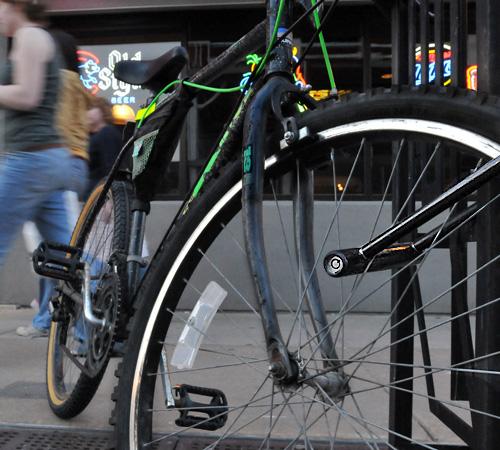Safety concerns raised in Ride of Silence

Photo Illustration by Wesley Fane
April 21, 2008
Editor’s Note: This is the first of a two-part series taking a closer look at the issues of bike safety and bike theft on campus.
Without opening their mouths, participants in the Ride of Silence will ask that bicyclists, pedestrians and vehicles peacefully share the road.
As part of the nationwide event, a single-file line of bicyclists will pedal around Campustown on May 21. The black bands around their arms will signify more than a common hobby.
The bands will designate that each rider knows someone who was injured or killed while biking.
“It was moving and powerful,” said Rick Langlois, chairman of ChampaignCountyBikes.org and computer-assisted instruction specialist at the University, who participated in the Ride of Silence last year. “It’s a solemn sort of ride. It’s not like any other ride when you’re just chatting and having fun.”
Get The Daily Illini in your inbox!
The ride wordlessly calls out against the inadequately acknowledged dangers of cycling that persist because of poorly designated paths, ignorance and irresponsibility on part of all patrons who share the roads.
“There are thousands and thousands and thousands of people, cars, bicycles, pedestrians — everything,” said Christopher Hawk, a University police officer. “And there is very little space to share.”
Hawk said the three E’s of traffic safety, Engineering, Education and Enforcement, need to be addressed on campus.
Engineering-wise, he said the 30-year-old north-south bike lane that runs down Wright Street should be removed in favor of a wider street.
Hawk said the lane breaches the findings of the Cross-Fisher study–; although seemingly counter-intuitive, the study discovered lanes that run parallel to the roadway put the bicyclist at about a three times greater risk of being injured in a crash.
“By being in the road, points of conflict are reduced because (bicyclists) are not dealing with the sidewalks, the driveway cut-outs and the pedestrian crossing areas any differently than a car would be.”
Improperly marked bike paths imperil cyclists, pedestrians and vehicles. For example, although the stop sign at the intersection of John and Wright streets applies to vehicle traffic, he said there is a “very good question whether it applies to a (northbound) bicyclist in the bike lane.”
Police are also starting to focus more on enforcing bike and pedestrian law.
Bicyclists in the street must follow the same laws as a vehicle. Disobeying the law can land bicyclists with a $75 ticket, but Hawk said his goal in stopping riders is to warn them about the laws, such as new legislation passed in January 2008 that allows bicyclists to signal a right turn by sticking out their right arm.
Going the wrong way down a one-way street or being in the wrong lane and riding without a headlight are prevalent in more than 70 percent of serious bicyclist injuries, Hawk added.
For the past 11 years, Cope Cumpston, art director at the University of Illinois Press, has been riding five to 10 miles a day.
“Until recently there has been very little awareness of the needs of cyclists and how to keep cyclists and pedestrians and cars out of each other’s way,” she said.
Students spill off buses into bike lanes. Bike lanes are irregular and not continuous across campus. Many are “seriously potholed and dangerous,” and others have “no shoulder whatsoever,” Cumpston said.
“If you have to swerve for whatever reason, you’re down,” she said.
However, within the last year, bike lanes with improved striping and the symbol of a bicyclist in the path have been added across campus.
“I can’t tell you how much that changes my everyday life to tell people that bicyclists are traveling here, and please be aware,” she said.
Despite safety problems, bikes are a healthy and “green” way to navigate campus.
The energy equivalent of one slice of pizza will move a car 14 feet and a pedestrian three blocks. It will move a cyclist about 10 blocks.
“Ounce for ounce, calorie for calorie, you get more out of a bicycle than you do from a car or walking,” Hawk said.






